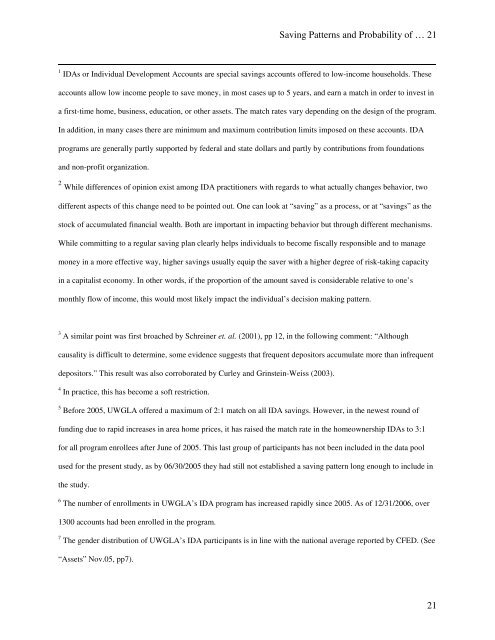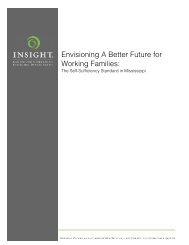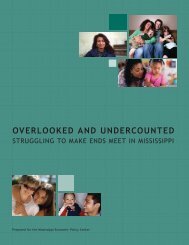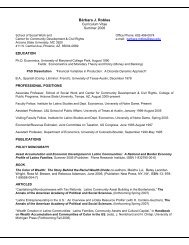Saving Patterns and Probability of Success in Individual ...
Saving Patterns and Probability of Success in Individual ...
Saving Patterns and Probability of Success in Individual ...
You also want an ePaper? Increase the reach of your titles
YUMPU automatically turns print PDFs into web optimized ePapers that Google loves.
<strong>Sav<strong>in</strong>g</strong> <strong>Patterns</strong> <strong>and</strong> <strong>Probability</strong> <strong>of</strong> … 21<br />
1 IDAs or <strong>Individual</strong> Development Accounts are special sav<strong>in</strong>gs accounts <strong>of</strong>fered to low-<strong>in</strong>come households. These<br />
accounts allow low <strong>in</strong>come people to save money, <strong>in</strong> most cases up to 5 years, <strong>and</strong> earn a match <strong>in</strong> order to <strong>in</strong>vest <strong>in</strong><br />
a first-time home, bus<strong>in</strong>ess, education, or other assets. The match rates vary depend<strong>in</strong>g on the design <strong>of</strong> the program.<br />
In addition, <strong>in</strong> many cases there are m<strong>in</strong>imum <strong>and</strong> maximum contribution limits imposed on these accounts. IDA<br />
programs are generally partly supported by federal <strong>and</strong> state dollars <strong>and</strong> partly by contributions from foundations<br />
<strong>and</strong> non-pr<strong>of</strong>it organization.<br />
2 While differences <strong>of</strong> op<strong>in</strong>ion exist among IDA practitioners with regards to what actually changes behavior, two<br />
different aspects <strong>of</strong> this change need to be po<strong>in</strong>ted out. One can look at “sav<strong>in</strong>g” as a process, or at “sav<strong>in</strong>gs” as the<br />
stock <strong>of</strong> accumulated f<strong>in</strong>ancial wealth. Both are important <strong>in</strong> impact<strong>in</strong>g behavior but through different mechanisms.<br />
While committ<strong>in</strong>g to a regular sav<strong>in</strong>g plan clearly helps <strong>in</strong>dividuals to become fiscally responsible <strong>and</strong> to manage<br />
money <strong>in</strong> a more effective way, higher sav<strong>in</strong>gs usually equip the saver with a higher degree <strong>of</strong> risk-tak<strong>in</strong>g capacity<br />
<strong>in</strong> a capitalist economy. In other words, if the proportion <strong>of</strong> the amount saved is considerable relative to one’s<br />
monthly flow <strong>of</strong> <strong>in</strong>come, this would most likely impact the <strong>in</strong>dividual’s decision mak<strong>in</strong>g pattern.<br />
3 A similar po<strong>in</strong>t was first broached by Schre<strong>in</strong>er et. al. (2001), pp 12, <strong>in</strong> the follow<strong>in</strong>g comment: “Although<br />
causality is difficult to determ<strong>in</strong>e, some evidence suggests that frequent depositors accumulate more than <strong>in</strong>frequent<br />
depositors.” This result was also corroborated by Curley <strong>and</strong> Gr<strong>in</strong>ste<strong>in</strong>-Weiss (2003).<br />
4 In practice, this has become a s<strong>of</strong>t restriction.<br />
5 Before 2005, UWGLA <strong>of</strong>fered a maximum <strong>of</strong> 2:1 match on all IDA sav<strong>in</strong>gs. However, <strong>in</strong> the newest round <strong>of</strong><br />
fund<strong>in</strong>g due to rapid <strong>in</strong>creases <strong>in</strong> area home prices, it has raised the match rate <strong>in</strong> the homeownership IDAs to 3:1<br />
for all program enrollees after June <strong>of</strong> 2005. This last group <strong>of</strong> participants has not been <strong>in</strong>cluded <strong>in</strong> the data pool<br />
used for the present study, as by 06/30/2005 they had still not established a sav<strong>in</strong>g pattern long enough to <strong>in</strong>clude <strong>in</strong><br />
the study.<br />
6 The number <strong>of</strong> enrollments <strong>in</strong> UWGLA’s IDA program has <strong>in</strong>creased rapidly s<strong>in</strong>ce 2005. As <strong>of</strong> 12/31/2006, over<br />
1300 accounts had been enrolled <strong>in</strong> the program.<br />
7 The gender distribution <strong>of</strong> UWGLA’s IDA participants is <strong>in</strong> l<strong>in</strong>e with the national average reported by CFED. (See<br />
“Assets” Nov.05, pp7).<br />
21














